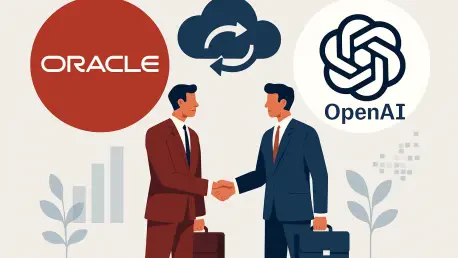In a groundbreaking move that has sent ripples through the tech and financial sectors, a staggering $300 billion cloud computing partnership between Oracle and OpenAI has been unveiled, marking one of the largest deals of its kind in recent memory. This five-year agreement, slated to begin in 2027, centers on OpenAI acquiring a massive 4.5 gigawatts of cloud compute capacity from Oracle, tied to their joint efforts on the enigmatic Stargate project. While specifics remain under wraps, the sheer scale of this collaboration has ignited intense speculation about its feasibility and long-term impact. As artificial intelligence continues to reshape industries at an unprecedented pace, this deal raises pivotal questions about financial sustainability, technological advancements, and strategic positioning for both companies. The industry is abuzz with curiosity, as analysts and stakeholders alike grapple with what this monumental agreement could mean for the future of cloud infrastructure and AI innovation.
Financial Challenges and Uncertainties
The financial underpinnings of this colossal deal have become a focal point of discussion among industry experts, particularly regarding OpenAI’s capacity to fund such an enormous commitment. With revenue projections estimated at $13 billion for the current year and profitability not anticipated until 2029, alongside a cash burn rate reportedly reaching $80 billion through that same period, skepticism abounds about how OpenAI will manage this expenditure. Insights from analysts suggest that venture capitalists and other financial backers are prepared to offer significant support, betting heavily on the explosive growth potential of AI-driven revenues. However, this speculative backing does little to ease concerns about the risks involved, especially if market dynamics shift unexpectedly. For Oracle, the arrangement appears more secure, as payment for hosting services is expected regardless of OpenAI’s financial health, assuming the contract remains intact. This asymmetry in risk exposure highlights a critical tension at the heart of the partnership.
Beyond the immediate financial concerns, the structure of the deal itself adds layers of complexity and uncertainty that could influence its ultimate success. The $300 billion figure is not a lump-sum payment but a phased commitment with various schedules, regional divisions, and clauses for renegotiation, according to industry observers. Key details such as pricing models, minimum purchase obligations, and contingency plans remain undisclosed, fueling speculation about the deal’s flexibility and potential vulnerabilities. Additionally, the role of external partners, such as Microsoft, which holds a right-of-first-refusal on new capacity with OpenAI, introduces further ambiguity. Could Microsoft emerge as a downstream reseller, or will it complicate the arrangement? These unanswered questions underscore the speculative nature of the agreement, leaving analysts to ponder whether the financial framework can withstand the volatile landscape of AI and cloud computing over the coming years.
Technological Ambiguities and Market Dynamics
Delving into the technological aspects of this partnership reveals a landscape rife with unknowns that could reshape the deal’s trajectory before it even begins in 2027. The specifics of what OpenAI is acquiring in terms of cloud compute capacity remain vague, with no public clarity on GPU technologies, networking tiers, or integration strategies involved in the 4.5-gigawatt commitment. Industry analysts point out that rapid advancements in alternative technologies, such as TPUs or custom ASICs, could disrupt the GPU market, potentially altering the value or focus of OpenAI’s investment. Such shifts might prompt a redirection of resources toward other solutions, challenging the foundational assumptions of the contract. This technological uncertainty is compounded by the long lead time before implementation, during which innovations could render current plans obsolete, raising questions about adaptability and foresight in the agreement’s design.
Equally significant are the broader market dynamics that could impact the partnership’s outcome as it progresses toward 2027 and beyond. The AI and cloud computing sectors are notorious for their fast-paced evolution, with changes in chip economics, per-query margins, and model differentiation capable of upending financial projections. For Oracle, the challenge lies in converting its substantial remaining performance obligations, valued at $455 billion, into tangible revenue while ensuring that capital expenditures do not outstrip returns. Delays or missteps in this process could jeopardize ambitious targets, such as achieving $144 billion in cloud revenue within a few years. Meanwhile, OpenAI must navigate potential shifts in demand for its AI models, which could affect the scalability of its cloud needs. These intertwined technological and market factors create a complex web of variables, making it difficult to predict whether the partnership will deliver on its transformative promise or stumble under unforeseen pressures.
Strategic Implications and Industry Positioning
From a strategic standpoint, this deal carries profound implications for Oracle’s standing within the competitive cloud computing arena, offering a chance to elevate its profile significantly. Often overshadowed by larger rivals, Oracle has been steadily enhancing its enterprise cloud infrastructure portfolio, and this high-profile collaboration with OpenAI could serve as a powerful catalyst for visibility. Industry voices suggest that hosting such a critical AI workload positions Oracle as a trusted provider for mission-critical applications, potentially drawing in a wave of new enterprise contracts across various sectors. Whether these contracts are tied to AI or other domains, the reputational boost could solidify Oracle’s foothold in a market increasingly defined by innovation and scale. This partnership, therefore, represents not just a financial transaction but a pivotal moment for Oracle to redefine its competitive narrative.
Looking at the broader industry impact, the agreement between Oracle and OpenAI underscores the growing intersection of AI and cloud infrastructure, setting a precedent for future collaborations of this magnitude. For OpenAI, the deal reflects a bold bet on scaling its AI capabilities through massive computational resources, though it must carefully manage the strategic risks tied to financial overextension and technological shifts. Meanwhile, the partnership signals to competitors and stakeholders that the stakes in AI infrastructure are higher than ever, potentially spurring similar large-scale investments across the sector. As the industry watches closely, the success or challenges of this deal could shape perceptions of risk and reward in AI-driven cloud partnerships. The coming years will reveal whether this strategic alignment delivers sustainable growth or becomes a cautionary tale of ambition outpacing execution in a rapidly evolving technological landscape.
Reflecting on a Bold Venture
Looking back, the $300 billion cloud computing partnership between Oracle and OpenAI stood as a daring leap into the future of AI infrastructure, encapsulating both the immense potential and the inherent risks of such a venture. The deal highlighted significant financial uncertainties for OpenAI, given its revenue constraints and the opaque terms of the agreement, while offering Oracle a platform to strengthen its market presence. Moving forward, both companies must prioritize transparency in financial planning and adaptability to technological shifts to mitigate risks. Close monitoring of market trends, especially in chip technology and cloud economics, will be essential to ensure the deal’s value holds over time. Additionally, fostering strategic alliances and contingency plans could provide a buffer against unforeseen disruptions. As the tech landscape continues to evolve, the lessons from this ambitious collaboration will likely inform future partnerships, balancing optimism for AI’s transformative power with the pragmatic need for robust execution strategies.









